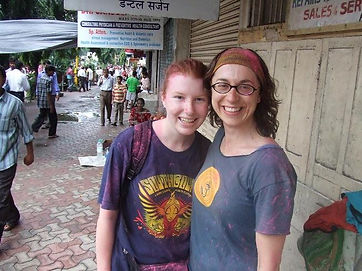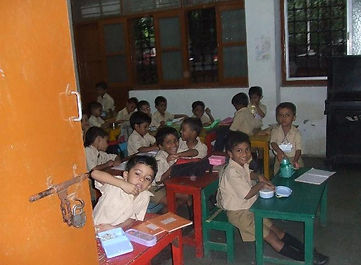Monthly Report - October 2007
Spring starts slowly…
It has been very busy amongst the vines this month as we try to consolidate on a solid start to spring and to keep the vines focused on the task at hand. With bud burst it is assured that the vines set many more canes than we have pruned them for, and these canes come out from all over the place, so as to make sure the energy expended on these all important “grape makers” are not diluted, we go through the vineyard cleaning the trunk of the vines and thinning out all the excess growth along the cordon. Unfortunately this can not be done in one pass, and though we have completed a whole month getting the vines into shape a further pass will be needed prior to the first wire lift in November. With the weather being a bit cooler this has pushed the vines growth around and unfortunately given us a bit more work to do. Another pair of jobs which has been ticked off the list were the mulching of the vineyard and weed spraying under the base of the vines to make sure nutrients are not “robbed” – this makes the vineyard look extremely neat and tidy and gladdens the heart of this vigneron (knowing full well that it will become more dishevelled as the season progresses).


Merlot vine (top) and View across the merlot vines (bottom)
Complexity is complex…
While going through a barrel tasting with our wonderful winemakers Sharna and Jane, it really struck home just how important it is to obtain a degree of complexity in your wine and how fortune determines this most critical of factors. In fact I would go out on a limb here and state that complexity is the most critical aspect of any fine wine – not balance, fruit, tannins, age worthiness, pH, Total Acidity, or any other definable aspect of wine. The reason I say this is that fine wine has to be more than a sum of its parts, it has to locate place, varieties, the vintage, and the style which was imparted by the choices the growers and winemakers made along the journey – and this is never a simple answer. A wine needs to present these aspects of information in beguiling ways to make the drinker “find” the little nuances and get the “ah ha” response as the light turns on over a period of drinking enjoyment.
This is where I find many of the fine wines of Europe have a slight advantage over new world wines, and it is this “undefinable” nature of complexity that may befuddle the wine scientists that makes our product so enticing. Reading through a wine magazine recently there was an article on the “finding” of the chemical that makes the pepper aroma in Shiraz – with the implication that you can dial up a pepper level for your wine regardless of quality and location, BUT will that “pepper” be a complex aroma, I would say not. The same has been applied to tannins and acid, and once you taste a wine heavily fortified with either you immediately note the sameness of the flavours and the intrinsically boring taste that you get. Any wine that has been dramatically altered by the additions of primary products to obtain balance, aromas, etc I believe lack the heart to be a complex and by default an interesting wine.
This is not a dig at the new world winemakers who create the wines from super ripe fruit and put the balance back into the wine by additions, or the old world makers who chaptalize sugar into the ferment to obtain a minimum alcohol level from their under ripe fruit. However, the greater the manipulation the lesser the capacity to generate complexity, and in effect the less fine the wine.
Our wine to date has only undergone the most minimal of alterations during the wine making process to ensure whatever complexity obtained from our site is passed through to the drinker, uninhibited. This makes all steps along the way even more critical as you can not afford to increase yields, over water, leave wires down, miss a protective spray etc as we want the site to expressed fully to those who drink our wine and the only way we can do that is to not dilute its “flavour”. Thus getting back to the barrel tasting, with the Cabernet Franc black in my glass I sat there and just smiled as it was a feast of aromas and tastes that gave me heart to think that this unaltered expression of our soil and vines really was difficult to pin like a moth and it can only mean that we are going ahead in the right direction.
OK spring can commence now.
Every month I think that in this section of my monthly report I will have nothing to say as the weather will be so similar that I may as well just type “ditto”. How wrong you can be, it seems like every crazy thing can and will happen when you least expect it. This month we were tracking along with nice ambient temperatures and growth was steady, and then BANG, Friday 26th a cold front reached the state with extremely cold unstable air and set off a large area of hail storms across the Margaret River region. Sitting at home (30 odd kilometres north of our estate), we watched thumb nail sized hail bank up against our sliding door and my heart sank. The next morning friends rang and indicated losses of up to 80% of their crop, and driving out in the freezing southerly air that came in behind this front I had a sense of dread. Driving straight into the vineyard the first thing I noticed was that all the canes were standing and the tips were evident – we had escaped with only the slightest damage. Like dodging a bullet there was a fair bit of relief.
With the month ending on a cool five days the average maximums and minimums were slightly depressed for October. Rainfall has actually been quite good as the falls have been light and evenly spaced keeping the canes in good health and promoting solid growth (though this is the last month in which rain is a pleasant addition!). The numbers for the month and last year’s figures are provided below:
October 2007:
Avg Maximum Temp 18.8°C
Daily Max recorded 25.6°C
Avg Minimum Temp 8.5°C
Daily Min recorded 4.4°C
Rainfall: 85.6mm
The 2007 maximum and minimum temperatures were much lower than last years figures, due to the reasons discussed above. Rainfall is a bit more in 2007 and was recorded over 12 days to 2006’s 10 days of rainfall.
October 2006:
Avg Maximum Temp 19.7°C
Daily Max recorded 28.4°C
Avg Minimum Temp 9.7°C
Daily Min recorded 6.0°C
Rainfall: 51.2mm
The comparison with Sonoma Valley continues with the data from the month of April 2007 (northern hemisphere’s equivalent to October) is presented below:
April 2007:
Avg Maximum Temp 24.0°C
Daily Max recorded 29.4°C
Avg Minimum Temp 6.8°C
Daily Min recorded 3.9°C
Rainfall: 91.4mm
The weather at the start of Spring in the Sonoma Valley continues to be very hot in comparison to Margaret River. The minimum temperatures however are much lower than Margaret River minimums and this must be the continental influence dominating the maritime influence from the Pacific Ocean 30 odd kilometers to the West. From reading and googling it appears that many lower sites are affected by the fogs and this depresses day time maximums and vineyards that have been planted higher in the Valley miss out on the fog but they get lower night time minimums. Rainfall was quite heavy in comparison to other months and this could be explained by 5 day of rain during the month, as the rest were rain free.
Pass after pass…
It is a month of long walks, completing the first of three wire lifts, thinning out all the extra growth, and continual setting of the plants into their best position on the cordon. Treated like a fitness program you sort of get into the swing of it, and to make it a tad more interesting we have recently purchased a puppy that spends time with Gail and I amongst the vines as we do our tasks. During a wine tasting amongst a group of friends I was surprised by the response to my monthly reports as many read it and brought up what I would mention in conversation. Rebecca did however state that she was more interested in the family and “events” that go on with us – so for Rebecca I will throw in a couple of photo’s below of my daughter's trip to India where she completed some charity work in Mumbai and in the countryside north of Mumbai in a hospice – thanks here go to our good friends Karen and Tristan who allowed Hannah to go on this trip and to get this life grounding experience.


Hannah and Karen in Mumbai (top) and Hospice north of Mumbai (bottom)
As usual the month ahead is a busy one with the release of our first white wine, the Blue Poles Viognier (please contact us if you would like to have access to this wine), and the Margaret River wine show which gives us an opportunity to see how everyone else is performing in the region.
All the best everyone.
Cheers
Mark Gifford
Blue Poles Vineyard
